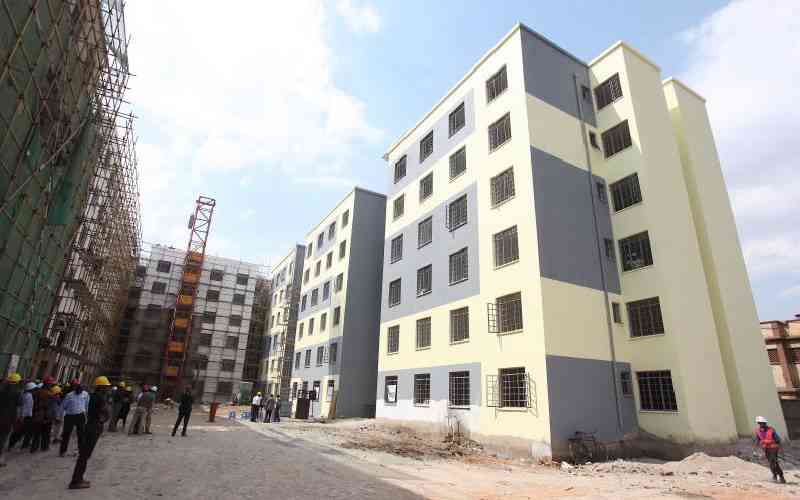
In a developing country of 40-plus million people that gained independence over 50 years ago, housing the masses has become a challenge that different stakeholders have been grappling with. Despite the many efforts aimed at addressing the housing problem, solution seems far away.
The most affected are the lower- and middle classes, who form about 90 per cent of the country’s population.
“The upper class, which is about 10 per cent, can afford to buy high-end houses in the market,” says Chris Chege, Head of Mortgage, Co-operative Bank of Kenya, at a recent real estate financing conference.
“As a country, we rank higher on the continent in mortgage uptake but still, 93.45 per cent of the population cannot afford mortgage.”
According to Chege, part of the problem is the mentality among many that a house must be big.
“Who said that a house must be 100 square feet? Who said that a building must be of brick and mortar? What if the houses being built were smaller but functional?” he asks, noting how urban life normally starts for most people.
“In university, we shared a small room among four people and we were all comfortable. After campus, people move into a bedsitter and it was comfortable. At what point was the need for a bigger house?”
Practical
Smaller houses are practical with small families or for those starting out in life. According to Charles Kahura, an architect, most people would like bigger rooms where the design allows for other fittings like wardrobes and space for more accessories.
“You cannot expect a house being built in Kileleshwa to be less than 140 square feet. Anyone who can own land over there would want a bigger house. In areas like Ruaka, most people would ask for house that measure about 90 square feet,” says Kahura.
Kahura explains that for low-income or people looking for a functional house, the size is not that much a priority.
“I have built a house measuring 39 square feet but some accessories like wardrobes had to be omitted from the design. The rooms were small but habitable, which was the main aim,” says Kahura, explaining that the size of a house is just one part of lowering the cost of building. Other factors include materials used, types of finishing and the cost of land.
“On mortgage, interest rates is a more important consideration than the cost of land or even the size of a house,” he says.
Chege say that one of the solutions to the housing shortage is adoption of alternative building technologies. “There is a need to change from brick and mortar. There are a number of alternative building technologies in the market that Kenyans must accept and use,” he says.
Stay informed. Subscribe to our newsletter
Solution
The other solution, according to the Principal Secretary in the Housing Ministry Mariam El Maawy, is for the stakeholders to come up with products that are tailor-made for the consumers.
“One of the solutions for the housing shortage in the country is to tailor-make products to suit different segments of the society. Different segments want different things. It is up to you (players in the sector) to come up with these products that will be relevant to consumers,” she says.
Many industry players view lack of affordability as the single most hindrance to home ownership. According to Sam Mabea of Abec Real Estate, interest rates will determine the rate of home ownership, not alternative technology.
“For those buying their houses through a mortgage, ownership is pegged on affordability of houses, not on alternative and cheaper technologies. Interest rate determines the number of homeowners, “ says Mabea, adding that Kenyans prefer brick and mortar as opposed to alternative technologies because of its reliability.
“If one has Sh5 million, it will be easier to go for brick and mortar than if they had Sh2 million,” says Mabea. “Brick and mortar is more reliable and has stood the test of time compared to newer technologies.”
“People like tried and tested things. As much as people know existing new and cheaper technologies, they will not easily adopt them if they have not seen them in use,” he says, adding that limitations of such technologies also do not favour a culture change.
Technology
“Some of these newer technologies do not allow for simple things like partitioning or dealing with the fact that some tribes have a problem with the bedroom door opening to a sitting room. Also, you cannot go up with most of these new technologies. You would rarely see a building of two floors or more made from an alternative technology. They are thus limiting.”
He says that newer technologies will only become an alternative once the reluctance people have towards them gets eroded, which will not happen anytime soon. “There is a need to see their practicability first.”
 The Standard Group Plc is a
multi-media organization with investments in media platforms spanning newspaper
print operations, television, radio broadcasting, digital and online services. The
Standard Group is recognized as a leading multi-media house in Kenya with a key
influence in matters of national and international interest.
The Standard Group Plc is a
multi-media organization with investments in media platforms spanning newspaper
print operations, television, radio broadcasting, digital and online services. The
Standard Group is recognized as a leading multi-media house in Kenya with a key
influence in matters of national and international interest.
 The Standard Group Plc is a
multi-media organization with investments in media platforms spanning newspaper
print operations, television, radio broadcasting, digital and online services. The
Standard Group is recognized as a leading multi-media house in Kenya with a key
influence in matters of national and international interest.
The Standard Group Plc is a
multi-media organization with investments in media platforms spanning newspaper
print operations, television, radio broadcasting, digital and online services. The
Standard Group is recognized as a leading multi-media house in Kenya with a key
influence in matters of national and international interest.










